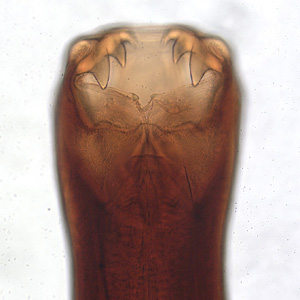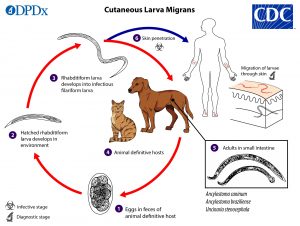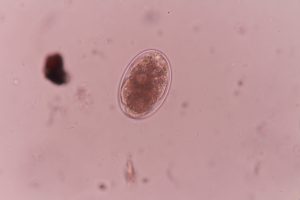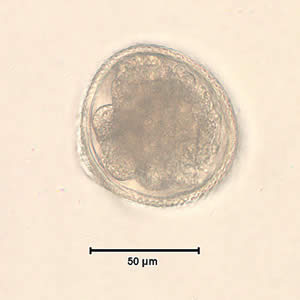We’ll admit that we are a little obsessed about poop. More specifically, our veterinarians obsess about the parasites that it can contains. There is a surprising amount of important information about intestinal parasites. Unfortunately, intestinal parasites do not often get the attention and respect they deserve as a cause of illness in our four-legged family members. For instance, we often hear talk about giving monthly heartworm preventative without understanding which intestinal parasites that prevention covers. Some heartworm preventatives do not cover for certain intestinal parasites. Fecal checks are recommended routinely, but not all forms of testing are the same. The more you know, the better you are able to care for your pet. In this blog, we are going to outline only the most common intestinal parasites that our vets see.
Hookworms

Image Credit: CDC
Hookworms are a type of intestinal parasite that are endemic throughout the US. They are particularly prevalent in the hot, humid regions such as Florida. In fact, in a survey conducted, it was found that approximately 36% of dogs in the southeastern United States tested positive for hookworms. In Hillsborough County alone last year there were roughly 1,800 cases of hookworms. These are only the cases that actually make it to the vet. It is very important to note that hookworms are a zoonotic disease. This means that they can be transmitted from dogs or cats to people. Here are some of the key facts about hookworms and and how you can protect your pets:
How does my pet get hookworms?
There are several different ways that pets can be exposed to hookworms.
-
- From the Environment: Most adult hookworms live in the small intestines of dogs and cats and shed eggs into the environment through the feces. These eggs then grow into a particular larval stage. These larvae enter a new host (dog or cat) by being ingested or penetrating the dog/cat’s skin. An animal may ingest the larvae by eating contaminated plant material, or even licking their paws after going for a walk. If larvae are living in the grass or dirt where pets live and play, they may also enter through the skin and migrate through the body.
- From other Animals: There are some animals that can become infected by hookworms, but are not considered a primary host. The worms typically do not develop to adults inside of these animals, but may stay dormant. If a dog or a cat ingests tissue from this animal, they may become infected with hookworms this way as well.
- From their Mother: Two key features of hookworms are their ability to migrate to areas outside of the intestines and to lie dormant. In adult dogs, these worms may live for years in a stage of arrested development. Once a dog becomes pregnant, these dormant worms may activate and accumulate in the mammary glands. They are then secreted in the milk to the puppies during nursing.

Image Credit: CDC
What do hookworms do?
Because hookworms can travel to multiple sites in the body, there are many ways they can cause illness. Hookworms attach to the inner lining of the intestines and feed on blood, so one of the most well-recognized issues is life-threatening low red blood cell counts (anemia), particularly in puppies. Puppies infected with hookworms may be weak, unable to gain weight, have a poor hair coat, become dehydrated and have dark, tarry diarrhea. Eventually, if left unchecked, puppies may die from hookworms. Almost every veterinarian has a story about a puppy that comes in looking white because they have lost so much blood to hookworms.
Adult dogs may harbor small numbers of worms without any signs, but if they acquire many worms over a short period of time, they may exhibit the same symptoms as puppies. With hookworms migrating to the lungs, respiratory disease with a cough and/or pneumonia can also develop.
Finally, hookworms may enter the body of dogs and cats through the skin. Severe redness, swelling, itchiness and secondary infections may occur where these larvae enter and migrate (usually around the feet).
How do I know if my pet has hookworms?
The traditional way to check for hookworms is to have a veterinary technician look for the presence of hookworm eggs in a fecal sample. These eggs are microscopic, and therefore, can only be visualized through a microscope. There are 3 different methods for checking for eggs, which are detailed below. There are some limitations to looking only for hookworm eggs. The first limitation is that hookworms usually take a minimum of 2-3 weeks to mature to adults and produce eggs, so early infections may not be noticed when only looking for hookworm eggs. Second, if a pet only has a few hookworms, or they are only female or only male hookworms, no eggs may be produced even though there are adults causing disease. Finally, if a pet consumes hookworm eggs from the environment, these eggs will never grow into adult hookworms in that pet, but may still be detected in a fecal sample resulting in a false positive. For these reasons an additional test, called the antigen test, is recommended as well, and is listed below.

Hookworm Egg
1. Fecal by direct smear: This is where a very tiny fecal sample is taken is mixed with a small amount of solution directly on a glass slide and examined under the microscope. This is the fastest test method, but is highly inaccurate, missing up to 75% of positive dogs.
2. Fecal Float: This test takes a larger fecal sample and mixes it with a solution in a tube, then allows a short period of time for the eggs to float to the surface of the tube and adhere to a glass slide. This slide is then examined under the microscope. This method is much better than the direct smear, but may still miss roughly 30% of hookworm positive dogs.
3. Fecal by Centrifugation: This method mixes a fecal with a solution and then actively spins the solution at high speed allowing the eggs to float to the surface and adhere to a slide. This slide is then reviewed by the veterinary technician. This is the best method for detecting hookworm eggs and is paired with an antigen test as the most recommended form of testing for intestinal parasites.
4. Antigen Testing: This is performed at some large veterinary laboratories and involves identifying a specific protein of the adult hookworms. This test picks up on adult worms that are too young to produce eggs and cases where there are fewer worms present.
How do I protect my pet from hookworms?
Most heartworm preventatives will protect pets from hookworms, however, some do not. It is important to check with your veterinarian to make sure the heartworm prevention you are using covers hookworms. If it does not, it may be worth switching preventatives or adding in a dewormer to protect your pet. These heartworm preventatives all work a little differently as well. Some only treat hookworms within a short window of when they are given and others can have a more long acting effect. Sometimes we will utilize these preventatives with longer effects if a pet is having repeated parasite issues.
If a pet has been diagnosed with hookworms, there are multiple dewormers that can also be used. These come in many varieties and often need to be dosed differently depending on the active ingredient. Be sure to speak with your veterinarian about the preventatives or dewormers you are using to make sure your pet is covered and you are giving the doses as needed to protect your pet.
Difficult to Treat Hookworms
Recently, veterinarians and parasitologists have identified a troubling problem. There are some strains of hookworms that do not respond to treatment. These worms may take several months, even years to clear from a pet’s body. There are several potential causes for this but many experts agree that some hookworms have become resistant to our treatment drugs. This is a particular problem in greyhounds. If your pet has hookworms that are not responding to treatment, your veterinarian may recommend combination therapy. During this type of treatment we combine monthly topical moxidectin with other common dewormers.
Roundworms

Image Credit: CDC
Roundworms, much like hookworms, are also quite prevalent in the southeastern United States. They have the potential to cause quite a bit of disease, particularly in young animals. Just like hookworms, they can also be transmitted from dogs to people and can cause significant illness in humans. We will help explain some of the similarities and differences between these two parasites.
How does my pet get roundworms?
Just like with hookworms, roundworms can be acquired by ingesting larvae, either in the environment or in tissue of another animal. Roundworm larvae are quite hardy and can live in the environment for longer periods of time than hookworms. They may also be acquired through milk going from a mother to her pups. In addition to these two methods, roundworms also live in several invertebrate hosts such as earthworms and can be transmitted through ingestion of one of these bugs. They may also go from the mother to the pups while the pups are still in the womb.
What do roundworms do?
Just like with hookworms, often the disease is much worse in young puppies, but roundworms can cause illness in dogs of all ages. The most common signs are failure to gain weight, poor hair coat, pot-bellied appearance, diarrhea and general lethargy. These larvae may migrate through the lungs before making their way to the small intestines. This may cause signs of lung disease including difficulty breathing and secondary infection and bleeding. While it is not common, these larvae may get lost along their migration through the body and can end up in the eyes or other areas of the body causing disease there as well.
How do I know if my pet has roundworms?

Image Credit: CDC
The types of testing done for roundworms are the same as those done for hookworms. The roundworms take a little longer to fully develop and start producing eggs than hookworms, so it might take longer to detect them after initial exposure.
How do I protect my pet from roundworms?
Many of the medications that help treat and prevent hookworms are also effective against roundworms. Because roundworms last a particularly long time in the environment, and are very difficult to kill once the ground has been contaminated, it is critically important to pick up a dog’s feces immediately after he has gone.
Whipworms
Whipworms are diagnosed a little less frequently than roundworms and hookworms, but are still considered endemic in the US and are common in tropical areas like Florida.
How does my dog get whipworms?
Unlike with roundworms and hookworms, there is only one way for dogs to get whipworms, by eating whipworm eggs. However, these eggs can live in the environment for years, so the dogs that randomly eat grass or other animal feces, are still at risk.
What do whipworms do?
Adult whipworms live in the small intestines and consume blood, tissue fluids and parts of the small intestines. Mild disease can cause bloody diarrhea, weight loss and dehydration. In severe stages, the pets can become quite ill and in rare cases even die from whipworm disease.
How do I know if my pet has whipworms?
Fecal tests can detect whipworms, however, this worm can be incredibly challenging to diagnose with the fecal float alone. One reason for this is that it takes several months for whipworms to become adults and start producing eggs. A pet can have whipworms for a while before the eggs will show up in a fecal float. The eggs are also shed intermittently. They could easily be missed if only a single fecal sample is tested. For this reason, it is strongly recommended to do fecal testing with both fecal flotation and antigen testing.
How do I protect my pet from whipworms?
This is also an area where whipworms distinguish themselves from the other parasites. There are several heartworm preventatives on the market that provide no coverage for this parasite. If you live in a tropical climate, it is really important to ask your vet what kind of testing and prevention they recommend for this parasite specifically.
Once a pet has been diagnosed with whipworms, there are a handful of dewormers that can be used to treat them. However, some of the dewormers that treat hookworms and roundworms will not treat whipworms, so make sure you consult with your veterinarian.
Tapeworms
There are several types of tapeworm species that affect our pets. One of the most common is Dipylidium caninum, which will be the focus of this section. Because this type of tapeworm is spread by fleas or lice, most pets are exposed to it if they are not on routine flea prevention. Please keep in mind that there are other types of tapeworms out there that may be spread or treated differently. Lizards, mice, and rats are all able to carry other species of tapeworm and share them with your pets.
How does my pet get tapeworms?
A dog or cat may pick up a tapeworm by ingesting fleas, lice or their larvae. Once these hosts are ingested, the tapeworm matures to an adult in the small intestines within 2-3 weeks. What is very important to remember about the tapeworm that differs from other intestinal parasites is that it must go through a flea or lice (intermediate host) for an animal to get it. This means that tapeworms cannot be directly transmitted from one patient to another.
What do tapeworms do?
After a tapeworm has matured to an adult, it starts to feed on some of the nutrients within the small intestines. Most of the time, a pet will not feel or act ill, but may lose some nutrients to the tapeworm. Some very young animals may get some obstruction of their intestines. This usually happens if there are a lot of tapeworms present.
How do I know if my pet has tapeworms?

Tapeworm Proglottid
Image Credit: CDC
This is another area where tapeworms differ from the other intestinal parasites. Tapeworms do not release eggs directly into the feces. Instead, they actually break off small parts of themselves called proglottids. Inside of these proglottids are up to 30 microscopic eggs. The proglottids look like tiny white grains of rice and are usually identified by pet owners.
Because the eggs are inside of proglottids they are frequently not identified on a fecal float unless one of the proglottids breaks open releasing the eggs into the stool. There is also not an antigen test for the adult tapeworms. For this reason, tapeworms are usually diagnosed from visual inspection of the proglottids.
How do I protect my pet from tapeworms?
The best protection against tapeworms is to protect your pet against fleas. There are many topical or oral flea preventatives available on the market. Your veterinarian can guide you on which ones may work best for your pet. One important thing to remember is that good flea prevention is required for all of the pets in the home.
If there are fleas in the environment (home and yard), it often helps to do a good treatment of these areas too.
Once a pet has contracted tapeworms, there is only one type of medication that helps treat them. It does come in various forms, and the doses may vary depending on the type of tapeworm being treated.
What Our Vets Want You To Know
Intestinal parasites are something we deal with every day. We understand that it seems a little odd for us to be so obsessed with checking your pet’s feces twice a year. We do it because we truly care about your pet’s health and your family’s health. Routine fecal checks and quality parasites prevention are the most effect ways to ensure our pet’s stay worm free. If you have questions about parasites or you think your pet might already have an intestinal visitor or two, our veterinarians and veterinary team are available to help. Give us a call at (813) 749-6863, or book an appointment via our website.












Leave A Comment